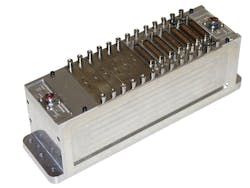Mission assurance, risk management, and cost, continuing the space COTS discussion
Response to “Protecting COTS space electronics at the component and module levels, a discussion” article in Intelligent Aerospace, 26 May 2017, by Dan Friedlander.
By Daniel Gleeson, MSc., Space Business Development Manager, Curtiss-Wright
We welcome the perceptive feedback from an experienced practitioner like Dan Friedlander in his article in Intelligent Aerospace on 26 May 2017.
In response, we’d like to address some of the points raised by Mr. Friedlander in his article in order to clarify and hopefully to provide an improved understanding of what we have achieved with the Smart Backplane innovation, and where it is best implemented in the context of spacecraft and mission design.
We agree with Mr. Friedlander’s view that the use of the Smart Backplane to improve the radiation tolerance of COTS module based equipment in spacecraft avionics subsystems is restricted to a range of applications. Indeed, the Smart Backplane was designed for use with a specific range of missions and to meet mission assurance requirements based on a certain class of avionics functional criticality and to operate within a given space environment for a given period. We are careful to map the specific mission requirements to the known performance of the Smart Backplane, while managing customer’s expectations and ensuring the success of the approach.
However, Mr. Friedlander provides his response without visibility into the details of the Smart Backplane design, which we can assure him has been through a rigorous review process by multiple external customers and agencies, and backed up with classic empirical evidence to validate the required performance. As you would expect, this process of design review, validation, and challenge is as it should be, and this ongoing process has improved the Smart Backplane design.
As Mr. Friedlander points out, tests are expensive, but the pay-off to the customer is the achievement of a substantially lower cost of delivering space missions. These tests also provide the hard evidence required to verify that the Smart Backplane meets the mission assurance requirements. This approach has proven very attractive to an increasing number of space customers in the U.S. and Europe.
Mr. Friedlander also makes an interesting point when he indicates that certain classes of “advanced low power technologies” may not respond well to repeated radiation induced latch-up events, even if recovered through fast power cycling. However, without disclosing proprietary details of our COTS module design and the radiation event protection approach designed by our engineers, all of whom have a background in designing electronics for long duration deep space missions, we can state that we have matched the Smart Backplane radiation effect protection approach to the components that are present in the existing COTS modules.
Finally, with regard to Mr. Friedlander’s point about risk management, as he is no doubt aware, risk is managed as a resource at the system and mission level, and flowed down to lower tier subsystems and equipment on the spacecraft. The innovative Smart Backplane approach provides the spacecraft system engineer with new risk and cost profiles for their design process. These new profiles inform the trade-off between risk and cost and inform the decisions of Program Managers and customers for future space missions. The outcome of this new analysis of risk and cost, where we report cost savings of 75 percent while still meeting the mission assurance requirements, is the result of data provided to us by our customers. This highly encouraging feedback strengthens our confidence that the Smart Backplane approach will have an exciting and positive role to play in developing a more affordable future in space for everyone.
RELATED READING
RELATED READING
Protecting COTS space electronics at the component and module levels, a discussion
Lowering the cost of spacecraft avionics with radiation-tolerant COTS electronics
COTS/EEE parts in space applications: evolution overview, revolution forward view
Search the Aerospace & Defense Buyer's Guide
The go-to resource for Intelligent Aerospace technology news & information:
Covering key topics
Across all market segments
Subscribe to the free Intelligent Inbox e-newsletter
Subscribe to receive all the latest aerospace technology news & information, delivered directly to your e-mail inbox twice a week (Tuesdays and Thursdays). Sign upfor your free subscription to the Intelligent Inbox e-newsletter at http://www.intelligent-aerospace.com/subscribe.html.
Connect on social media
Keep pace with aerospace innovation and opportunities via your favorite social media channels. Connect with Intelligent Aerospace on Twitter (@IntelligentAero), LinkedIn,Google+, and Instagram.



